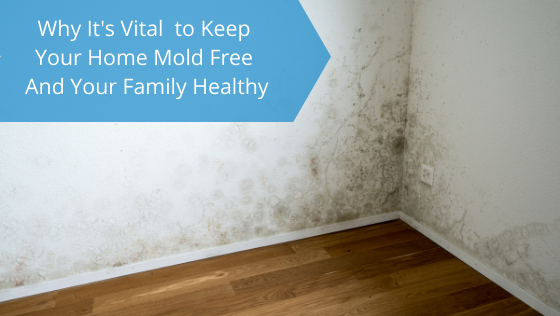Basement mold and mildew can be a serious issue, potentially causing asthma or allergies for your family. Forty percent of the air you breathe in your home comes from your basement. Even when mold is no longer in the environment, the problems can continue. By understanding why mold is dangerous, how to keep it under control in your basement and how to treat it, you can keep your family safe from these dangers. In this article, we’ll discuss these issues, making it easier for you to handle basement mold and mildew if it pops up in your home.

Mold and Mildew Dangers
Health issues caused by mold in basement spaces can be permanent if not taken care of, especially for young children. However, even healthy adults can develop asthma from mold and mildew exposure, causing your immune system to become more reactive over time. People susceptible to allergies or immunological responses are especially vulnerable to health problems from mold and mildew. Mildew in basement spaces can also be problematic, as it indicates that conditions are ripe for more serious mold and mildew problems to start growing. You may experience allergies flaring up due to the spores that are floating around in the air. Red eyes, itchy eyes, congestion, and similar symptoms common to allergic reactions may indicate that you need to look at basement mold removal. Coughing and wheezing are other examples of how mold and mildew can impact your health as well.
How to Check for Mold in Basement Spaces
What does basement mold look like? How common is mold in basements spaces? These are common questions when homeowners develop a range of concerns about mold in their homes. To start, you’ll need to understand where mold is likely to grow before you start looking. Dark, cool, damp places are most likely, which is why basement mold is such a common issue. You can also check under sinks or in bathrooms that don’t have good ventilation and tend to stay damp after showers.
Though you can smell mold in the air, it’s not the safest approach. Wearing a face mask to help prevent the spores from passing into your lungs can help protect you while you’re trying to find the source of the mold, especially if you can find an N95 or P95 mask or a respirator with that high of a level of filtration or higher. Mold will appear as collections of black or green spots. It may look like dirt, so make sure that you’re looking at mold, especially if it’s on the floor or other place where you’d expect to see dirt.
If the spots are in a damp area that tends to be dark, these spots are much more likely to be mold. It also tends to have a distinct scent, so if you smell something unusual in your basement, especially if it’s coming from a dark, damp location, you’re likely smelling mold.
Mold Testing
To check for certain that you have mold, especially if it’s difficult to find, you’ll want to have testing performed to determine whether it’s present. However, that doesn’t mean that you have to shell out a lot of cash for professional testing, though these services can do an impressive job of finding mold in your home.
A much simpler test is exposing potential mold spots to bleach. Mold and dirt react very differently to bleach exposure. Dab some bleach on the spot, and if it lightens up, you’re almost certainly working with mold. If it stays dark, it’s probably dirt of some type. However, if a spot continues to come back after you’ve cleaned it several times, it is likely mold.
Eliminating Mold
After you’ve located the mold in your basement or other damp areas of your home, you may be able to get rid of it for the moment. Mold can temporarily be cleaned by using soap and water or even bleach in, particularly challenging cases. However, if you don’t solve the root of the mold problem, it will continue to come back. If your home is impacted to a high degree or you have allergies, basement mold removal services can help keep it from coming back.
Removing the conditions that are causing the mold is the only way to make sure that your basement mold removal process is permanent. Adding a dehumidifier, sealing leaks in your basement, repairing leaking pipes, improving ventilation, and similar approaches allow you to remove the source of the mold’s habitat, making it less likely to recur.
An easier approach is starting by sealing your basement, using a qualified contractor who understands the issues with moisture getting into your basement. This allows the moisture that is coming into your basement to be blocked, limiting the moisture and getting rid of the mold problem where it’s at its worst.
Keeping Your Home Free of Basement Mold
By repairing the root of the moisture sources in your home and basement, you can keep your home mold-free, keeping your family healthy. If you’re ready to look at basement sealing as a remedy for your basement mold removal process, the experienced professionals at Moisture Loc are prepared to help. Please feel free to reach out with any questions or schedule a free consultation for more information.

